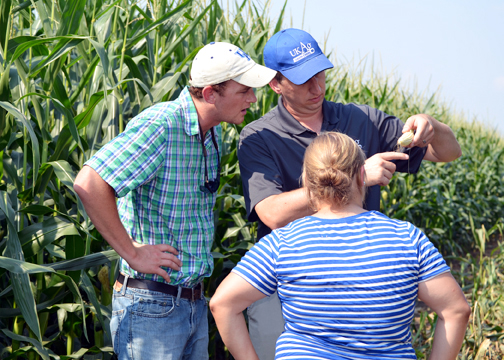Irrigation study fulfills a need for Kentucky farmers
Irrigation study fulfills a need for Kentucky farmers

A disastrous 2012 growing season has piqued many Kentucky farmers’ interest in learning whether irrigation is feasible for their operation, but there is little information for them to go on; few previous research studies have been conducted about irrigation in Kentucky.
Lauren Settles and Brad Hagan, University of Kentucky students in the College of Agriculture, Food and Environment, spent their summer in Western Kentucky cornfields conducting a study with the idea of helping area farmers make educated decisions regarding irrigation.
“The goal of our study was to create a basis for a guide book on irrigation use for farmers, not only in our area, but in Western Kentucky,” said Settles, a sophomore and intern with the Henderson County office of the UK Cooperative Extension Service. “Irrigation has recently become a big thing, especially in this area with the drought last year and our location on the Ohio River.”
Henderson and neighboring Daviess County are ideal locations for the study. Irrigation already has a strong foothold in the area. It’s an attractive option for area producers because of the readily available water supply from the Ohio and Green rivers and their tributaries, along with large, flat fields and soil types with limited water-holding capacity, said Mike Smith, Henderson County extension agent for agriculture and natural resources. Clint Hardy, Smith’s counterpart in Daviess County, estimated that there are about 300 center pivot irrigation systems between the two counties, about 50 of which were installed over the winter, largely because of the 2012 drought.
Settles and Hagan, a senior and Daviess County extension intern, worked with Chad Lee and Edwin Ritchey, UK extension grain crops and soils specialists, respectively, to develop questions for a producer survey. They then surveyed 13 producers about their irrigation equipment and agronomic and management practices.
Settles and Hagan recorded weekly field observations on temperatures, humidity levels, wind speed, soil moisture and crop growth stages. The students collected moisture amounts from rain gauges located inside and outside the center pivots to determine the amount of water the crop received from rainfall and from irrigation.
In addition to irrigation, their study will determine the plant’s nitrogen uptake and utilization. After producers made their regular nitrogen fertilizer applications this spring, Hagan and Settles measured a 30-by-50 foot strip in each field and made an additional nitrogen application when the crop reached around the V5 and V6 growth stages. Settles and Hagan collected plant tissue, soil fertility and nitrate samples from inside and outside the strip in each field before making the additional nitrogen application. They collected samples again at tasseling to determine if the late-season nitrogen application had any influence on the crop.
Hagan and Settles compiled and shared individual field data with farmers in the study and with those who attended UK’s Irrigation Forum at the UK Research and Education Center in Princeton. Lee and Ritchey will use their data as the basis for a guide on irrigated grain crop production in Kentucky. The data will also help extension specialists direct their efforts to better meet the needs of farmers who already have irrigation or those who are interested in it.
“We have water supplies in areas of the state that can fulfill homeowner needs, recreational uses and irrigate crops,” Lee said. “We want to help producers maximize their irrigation systems to reduce risk, increase profits and produce a high quality crop that sustains animals and people. Brad and Lauren have conducted excellent work this summer that is useful to producers, county agents and faculty.”
Settles and Hagan, both plant and soil science majors, agreed the project was a great learning experience for them.
“Field work teaches you more than a classroom can,” Hagan said. “I now have more knowledge about the science behind determining growth stages and how a plant uptakes nitrogen. It’s provided me with a lot of insight about what an agronomist does.”
Extension Research Weather

